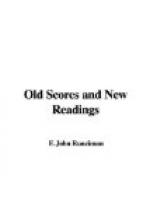main intentions broadly carried out, leaving a good
deal of minor detail to look after itself, and not
complaining if a few notes fell under the desks at
the back of the orchestra. Lamoureux had laboriously
rehearsed every inch of his repertory until it was
note-perfect, and each of his men knew the precise
bowing, phrasing, degree of piano or forte, and tempo
of every minutest phrase. Now I do not mean by
this that the orchestras on which Richter and Mottl
performed played many wrong notes, while the Lamoureux
orchestra played none; and still less do I mean that
Lamoureux got finer results than Richter or Mottl.
So far as the mere notes are concerned, the Englishmen
who played for the German conductors acquitted themselves
quite as well as the Frenchmen who played for Lamoureux.
Both made mistakes at times; and a seemingly paradoxical
thing is that when a Lamoureux man stumbled all the
world was bound to hear it, whereas in our English
orchestras a score of mistakes might be made in an
evening without many of us being much the wiser.
The reason for this is the reason why the playing of
Lamoureux on his trained orchestra, for all its accuracy,
was not better than, nor in many respects so good
as, the playing of Richter and Mottl on the scratch
orchestras which their agents engaged for them.
Probably few uninformed laymen have any notion of
the extent to which mere noise is responsible for
the total effect of a Wagner piece or a Beethoven
symphony—not the noise of big drum, cymbals
and so on; but the continuous slight discords caused
by some of the players being various degrees in front
and others various degrees behind; the scratching
produced by uncertain bowing, or by an unfortunate
fiddler finding himself a little behind the general
body (as he does sometimes) and making a savage rush
to catch it up; the hissing of panting flautists;
and the barnyard noises produced by exhausted oboe-players.
Even with Richter, stolid and trustworthy though he
is, these unauthorised sounds count for a great deal;
and with a conductor like Mottl, who varies the tempo
freely in obedience to his mood in the most rapid
pieces, they count for very much more. They result
in a continuous murmur which, so to speak, fills the
interstices in the network of the music, covering
wrong notes, and giving the mass of tone a richness
and unity which otherwise it would lack. In such
movements as the Finale of the Fifth symphony this
continuous murmur does the work done for the piano
by the upper strings without dampers and the lower
ones when the pedal is pressed down; it gives solidity
and colour to the music; and certainly half the effect
in fine renderings of “The Flying Dutchman”
overture, the Walkuerenritt, and the Fire-music, is
due to it. But Lamoureux’s men had practised
so long together under their conductor’s beat
that all the instruments played like one instrument,
no matter how the tempo was varied; the bowing of
each passage had been considered and finally settled,




